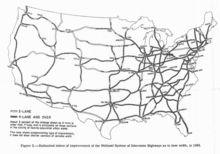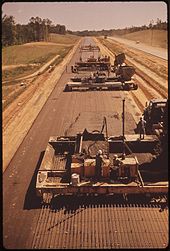Hay Friends Of Bitter, Bitter Coffee Park this Time will invite you in the stile of the chat coffe shops on:
Dwight D. Eisenhower National System of Interstate and Defense Highways [Main article: Federal Aid Highway Act of 1956]
Highway shields for Interstate 80, Business Loop Interstate 80, and the Eisenhower Interstate System
Interstate Highways in the 48 contiguous states. Alaska, Hawaii, and Puerto Rico also have Interstate Highways. (See version with numbers.)
System information
Length
48,191 mi (77,556 km)
Formed
June 29, 1956
Highway names
Interstates
Interstate X (I-X)
System links
☆☆☆☆☆
A boom in road construction followed throughout the decade of the 1920s, with such projects as the New York parkway system constructed as part of a new national highway system. As automobile traffic increased, planners saw a need for such an interconnected national system to supplement the existing, largely non-freeway, United States Numbered Highways system. By the late 1930s, planning had expanded to a system of new superhighways.
In 1938, President Franklin D. Roosevelt gave Thomas MacDonald, chief at the Bureau of Public Roads, a hand-drawn map of the United States marked with eight superhighway corridors for study. In 1939, Bureau of Public Roads Division of Information chief Herbert S. Fairbank wrote a report called Toll Roads and Free Roads, "the first formal description of what became the interstate highway system" and, in 1944, the similarly themed Interregional Highways.
Federal Aid Highway Act of 1953
The Interstate Highway System gained a champion in President Dwight D. Eisenhower, who was influenced by his experiences as a young Army officer crossing the country in the 1919 Army Convoy on the Lincoln Highway, the first road across America. Eisenhower gained an appreciation of the Reichsautobahn system, the first "national" implementation of modern Germany's Autobahn network, as a necessary component of a national defense system while he was serving as Supreme Commander of Allied Forces in Europe during World War II.[12] In 1954, Eisenhower appointed General Lucius D. Clay to head a committee charged with proposing an interstate highway system plan. Summing up motivations for the construction of such an interstate highway system, Clay stated,
It was evident we needed better highways. We needed them for safety, to accommodate more automobiles. We needed them for defense purposes, if that should ever be necessary. And we needed them for the economy. Not just as a public works measure, but for future growth.
Clay's committee proposed a 10-year, $100 billion program, which would build 40,000 miles (64,000 km) of divided highways linking all American cities with a population of greater than 50,000. Eisenhower initially preferred a system consisting of toll roads, but Clay convinced Eisenhower that toll roads were not feasible outside of the highly populated coastal regions. In February 1955, Eisenhower forwarded Clay's proposal to Congress. The bill quickly won approval in the Senate, but House Democrats objected to the use of public bonds as the means to finance construction. Eisenhower and the House Democrats agreed to instead finance the system through the Highway Trust Fund, which itself would be funded by a gasoline tax. In June 1956, Eisenhower signed the Federal Aid Highway Act of 1956 into law. Under the act, the federal government would pay for 90 percent of the cost of construction of Interstate Highways. Each Interstate Highway was required to be a controlled-access highway with at least four lanes and no at-grade crossings.
The publication in 1955 of the General Location of National System of Interstate Highways, informally known as the Yellow Book, mapped out what became the Interstate Highway System. Assisting in the planning was Charles Erwin Wilson, who was still head of General Motors when President Eisenhower selected him as Secretary of Defense in January 1953.
Construction
1955 map: The planned status of U.S Highways in 1965, as a result of the developing Interstate Highway System
I-15 and US 20 junction at exit 118 in Idaho Falls, Idaho before completion in 1964
I‑55 under construction in Mississippi, photo from May 1972
Three states have claimed the title of first Interstate Highway. Missouri claims that the first three contracts under the new program were signed in Missouri on August 2, 1956. The first contract signed was for upgrading a section of US Route 66 to what is now designated Interstate 44. On August 13, 1956, Missouri awarded the first contract based on new Interstate Highway funding; this work began on US 40 (now I-70) in St. Charles County.
Kansas claims that it was the first to start paving after the act was signed. Preliminary construction had taken place before the act was signed, and paving started September 26, 1956. The state marked its portion of I-70 as the first project in the United States completed under the provisions of the new Federal-Aid Highway Act of 1956
The Pennsylvania Turnpike could also be considered one of the first Interstate Highways. On October 1, 1940, 162 miles (261 km) of the highway now designated I‑70 and I‑76 opened between Irwin and Carlisle. The Commonwealth of Pennsylvania refers to the turnpike as the Granddaddy of the Pikes.
Milestones in the construction of the Interstate Highway System include:
October 17, 1974:
Nebraska becomes the first state to complete all of its mainline interstate highways with the dedication of its final piece of I-80.
Nebraska becomes the first state to complete all of its mainline interstate highways with the dedication of its final piece of I-80.
October 12, 1979:
The final section of the Canada to Mexico freeway Interstate 5 is dedicated near Stockton, California. Representatives of the two neighboring nations attended the dedication to commemorate the first contiguous freeway connecting the North American countries.
The final section of the Canada to Mexico freeway Interstate 5 is dedicated near Stockton, California. Representatives of the two neighboring nations attended the dedication to commemorate the first contiguous freeway connecting the North American countries.
August 22, 1986:
The final section of the coast-to-coast I-80 (San Francisco, California, to Teaneck, New Jersey) is dedicated on the western edge of Salt Lake City, Utah, making I-80 the world's first contiguous freeway to span from the Atlantic to Pacific Ocean and, at the time, the longest contiguous freeway in the world. The section spanned from Redwood Road to just west of the Salt Lake City International Airport. At the dedication it was noted that coincidentally this was only 50 miles (80 km) from Promontory Summit, where a similar feat was accomplished 120 years prior, the laying of the golden spike of the United States' First Transcontinental Railroad.
The final section of the coast-to-coast I-80 (San Francisco, California, to Teaneck, New Jersey) is dedicated on the western edge of Salt Lake City, Utah, making I-80 the world's first contiguous freeway to span from the Atlantic to Pacific Ocean and, at the time, the longest contiguous freeway in the world. The section spanned from Redwood Road to just west of the Salt Lake City International Airport. At the dedication it was noted that coincidentally this was only 50 miles (80 km) from Promontory Summit, where a similar feat was accomplished 120 years prior, the laying of the golden spike of the United States' First Transcontinental Railroad.
August 10, 1990:
The final section of coast-to-coast I-10 (Santa Monica, California, to Jacksonville, Florida) is dedicated, the Papago Freeway Tunnel under downtown Phoenix, Arizona. Completion of this section was delayed due to a freeway revolt that forced the cancellation of an originally planned elevated routing.
The final section of coast-to-coast I-10 (Santa Monica, California, to Jacksonville, Florida) is dedicated, the Papago Freeway Tunnel under downtown Phoenix, Arizona. Completion of this section was delayed due to a freeway revolt that forced the cancellation of an originally planned elevated routing.
September 12, 1991:
I-90 becomes the final coast-to-coast Interstate Highway (Seattle, Washington to Boston, Massachusetts) to be completed with the dedication of an elevated viaduct bypassing Wallace, Idaho. This section was delayed after residents forced the cancellation of the originally planned at-grade alignment that would have demolished much of downtown Wallace. The residents accomplished this feat by arranging for most of the downtown area to be declared a historic district and listed on the National Register of Historic Places; this succeeded in blocking the path of the original alignment. After the dedication residents held a mock funeral celebrating the removal of the last stoplight on a transcontinental Interstate Highway.
I-90 becomes the final coast-to-coast Interstate Highway (Seattle, Washington to Boston, Massachusetts) to be completed with the dedication of an elevated viaduct bypassing Wallace, Idaho. This section was delayed after residents forced the cancellation of the originally planned at-grade alignment that would have demolished much of downtown Wallace. The residents accomplished this feat by arranging for most of the downtown area to be declared a historic district and listed on the National Register of Historic Places; this succeeded in blocking the path of the original alignment. After the dedication residents held a mock funeral celebrating the removal of the last stoplight on a transcontinental Interstate Highway.
October 14, 1992:
The original Interstate Highway System is proclaimed to be complete with the opening of I-70 through Glenwood Canyon in Colorado. This section is considered an engineering marvel with a 12-mile (19 km) span featuring 40 bridges and numerous tunnels and is one of the most expensive rural highways per mile built in the United States. Although this was claimed the final section of Interstate Highway to open, at the time this section was dedicated there were still missing interchanges elsewhere in the system, making some Interstate Highways not contiguous.
The original Interstate Highway System is proclaimed to be complete with the opening of I-70 through Glenwood Canyon in Colorado. This section is considered an engineering marvel with a 12-mile (19 km) span featuring 40 bridges and numerous tunnels and is one of the most expensive rural highways per mile built in the United States. Although this was claimed the final section of Interstate Highway to open, at the time this section was dedicated there were still missing interchanges elsewhere in the system, making some Interstate Highways not contiguous.
The initial cost estimate for the system was $25 billion over 12 years; it ended up costing $114 billion (adjusted for inflation, $425 billion in 2006 dollars) and took 35 years.
☆☆☆☆☆









No comments:
Post a Comment
Obrolan yang baik bukan hanya sebuah obrolan yang mengkritik saja, tetapi juga memberi saran dan dimana saran dan kritik tersebut terulas kekurangan dan kelebihan dari saran dan kritik.
BERIKAN OPINI SAHABAT BITTER TENTANG TULISAN TERSEBUT